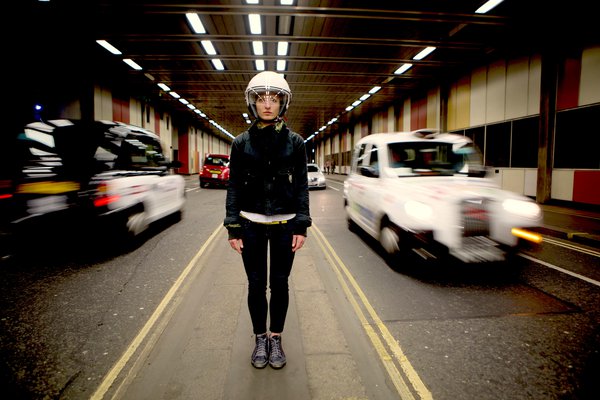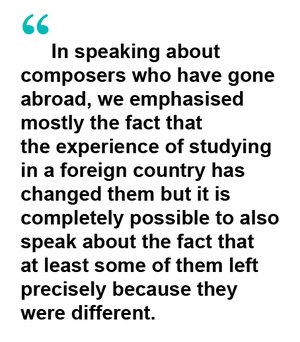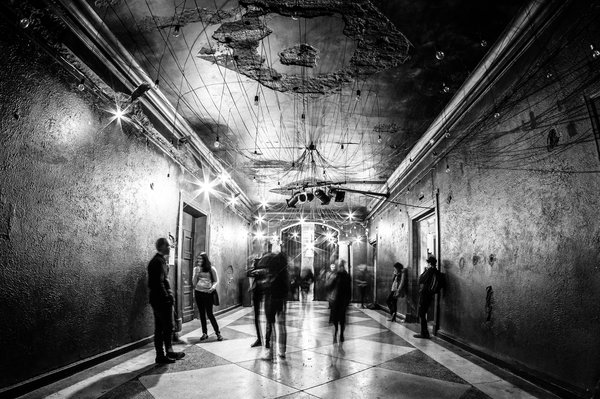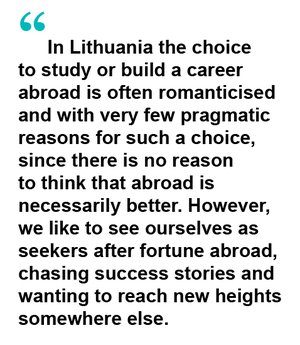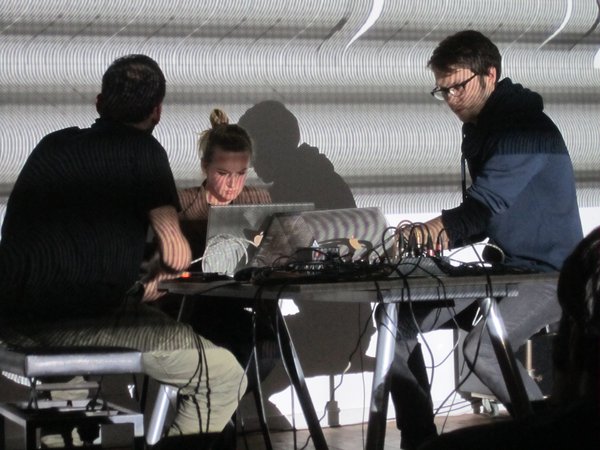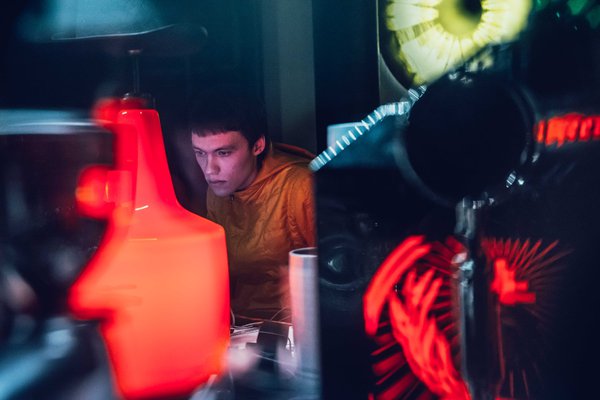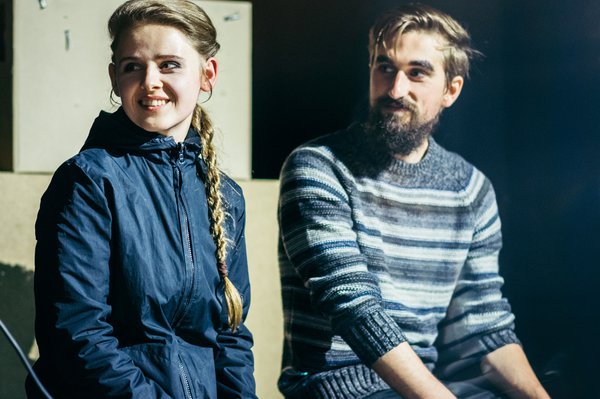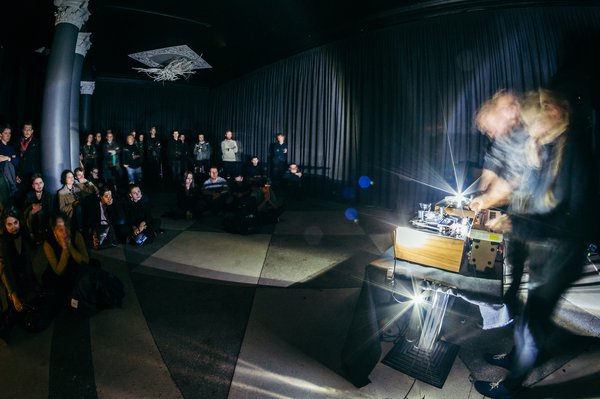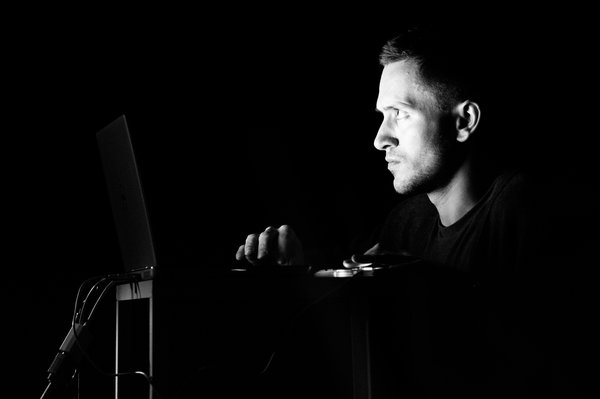Edvardas ŠUMILA | Far Away but Ever Closer: Young Lithuanian Composers Abroad
The phenomenon which can be described as emigration and the formation of diasporas in other cultural environments beyond the borders of our country has intensified amongst members of Lithuania’s musical communities over the past decade. We could talk about several different aspects. On the one hand, it is connected with the search by the most talented and innovative people for a place which suits them best and is most appreciative of them. This also happens in other areas where high-level qualifications are required and can be compared to what is often called the ‘brain drain’ which, regardless of how you look at it, has a negative connotation and is characteristic of the postsocialist bloc and the smaller EU countries. It is the larger countries which draw them in and reap the dividends both symbolic and real.
On the other hand, like at the juncture of the 19th and 20th centuries or the interwar period, we do not live in hermetically sealed European states – we share the same cultural lungs with which we breathe and for this reason the circulation of information and cultures is vital. Higher institutions of learning, regardless of what kind they are, throw, as it were, a gigantic amount of information at young people and that inevitably has an influence on and is reflected in the creative work of young artists. There are a host of other factors which separates out the way this information in shared. One of them is space; being in a certain space forms us not just virtually. Life, walking in different air will inevitably allow a different kind of wind to blow through the corridors of our minds as well. That is one of the reasons why speak about the geography of music. There are also other aspects, such as how information reaches us. Who will deny that what we seemingly imagine depends on the message we receive and which becomes almost too hard to comprehend because of the unduly long path it has travelled or the subject itself not being in that place and at that time; this is a general problem of communication true of both music and the arts in general, as well as other political phenomena, the elucidation of which depends in large part on the media shaping our attitudes and convictions.
After almost two decades since the declaration of independence we were still talking about the generations of composers – the 2009 text by the musicologist Asta Pakarklytė ‘The (re)generation of Lithuanian contemporary music’ is in this regard symptomatic, although already trying to deny the possibility of talking about generations. The composers presented then as a generation – Mykolas Natalevičius, Albertas Navickas, Rūta Vitkauskaitė and Rita Mačiliūnaitė – are today scattered over various geographical locations and seem to be a part of something bigger in their activities. There is one thing that distinguishes them somewhat in the above-mentioned context and that is the fact that they are all alumni of the Lithuanian Academy of Music and Theatre, who had studied in a quite traditional department of composition; they later chose an autonomous path, becoming monads – almost nothing remained of the former joint projects. Over that time the Department of Composition itself changed, the Music Innovation Studies Centre was opened, and the contingent of lecturers became younger. However, a little more than just that took place.A considerable number of young people committed to composition decided to study abroad, the larger part of the diaspora was formed relatively recently; those who had graduated from the National M. K. Čiurlionis School of Art (which spans the twelve-year learning cycle), were, most probably, quite well acquainted with the existing local situation in the teaching of composition. They could also have been frightened off by the reform of higher education begun in 2009, threatening to bring in large fees for education. That made them think even harder about quality as well. However, another section of young people generally speaking did not have a close connection with the Lithuanian contemporary music establishment.
To talk today about the generations is becoming completely impossible but what we are talking about could be called constellations having things in common in one way or another. However, they cannot be lumped together and treated as one entity, moreover, their existence can also be denied. And one more thing: perhaps the greatest part of the composers and artists about whom we are speaking can be ascribed to a particular period, that is, those born about 1990 (these are people who most probably were formed after the declaration of independence but I would not dare to describe even this generation (my own) in such a way since I still remember the triangular packets of milk and many other things, fostering reminiscences of the former regime), but there are completely different examples, who would not fit to this definition and would prove that the question is not generational. There has been a number of composers who previously chose education, creative work and life abroad, such as Vykintas Baltakas (Belgium), Diana Čemerytė (Germany), Ignas Krunglevičius (Norway), Žibuoklė Martinaitytė (US), Justė Janulytė (Italy), Lina Lapelytė (UK), Egidija Medekšaitė (UK) and others, constantly balancing between two or even several geographical locations. Immediately from the time when the opportunities appeared for artists to expand their knowledge and to forge a career abroad, it became slowly possible to present oneself in Lithuania as well, adding to the local cultural climate what the local music scene had not yet assimilated. The formation of this kind of contingent of artists, the appearance of new connections and the spread of other kinds of expression, for example, a different kind of attitude towards festivals, programmes, the setting up of creative workshops, when the main accent ever more clearly becomes distant from a specific geographical context, tradition, or simply the presentation of new work, coming closer towards the exchange of ideas and the formation of experiences, depending more on differences and not similarities. One of those still comparatively new initiatives is the electronic music festival Ahead, which from the very start brought together artists who had chosen a more traditional career path in Lithuania and those who had decided to leave and see what is happening further way from our borders.In Lithuania the choice to study or build a career abroad is often romanticised and with very few pragmatic reasons for such a choice, since there is no reason to think that abroad is necessarily better. However, we like to see ourselves as seekers after fortune abroad, chasing success stories and wanting to reach new heights somewhere else. Perhaps this is because of the peculiar exoticism of the former image of the ‘Soviet composer in the West’. However, these phenomena slowly recreate themselves while the music scene is inevitably and increasingly becoming more global; whether that is good or bad is a subject for another text.
A problem arises when we want to include all those who have chosen to study at institutions of higher education abroad. Very few make any real effort to make themselves known in Lithuania but see themselves more as a part of a larger European context, while at the same time acting in a broad cultural space. It would be quite strange if it were any different. For this reason, I shall try to restrict myself to those composers who have never or have hardly studied in Lithuania and in fact in recent years a good number of them have appeared on the scene.
One of the more interesting trends followed by composers from Lithuania who have studied abroad is sonology – something that one might say has no analogy in Lithuania. On the one hand, one could consider those studying at the Kaunas University of Technology to fit into that mould but there it is more the technical aspects that are explored and the students trained to work as sound directors and, in part, as producers. The Institute of Sonology in The Hague presents itself as an educational institution solely orientated to electronic and electroacoustic music, as well as the art of sound, and where the attempt is made to focus on the convergence of algorithmic composition and the relationship between sound and space – besides that, the tendency there is the discourse on sound as an object of the exact sciences. This conception of study frees itself from problems that arise from combining the contemporary arts and tradition in the old academies of music where those studying there define themselves as composers. A good number of composers from Lithuania have in fact chosen to study there. One of these artists is Aurimas Bavarskis who, in the context of the composers discussed in this text, is somewhat older yet he perfectly illustrates what we are attempting to talk about here. After graduating with a Bachelor’s degree in sonology studies, he went on to study media technologies. Like for many who study sonology, one of the main features is programming and scientific access. And although his education and field of interests are more concentrated on sound, his work reminds one more of media art – this is strengthened even more by his collaboration of various kinds with other artists, for example, in projects like Duel Protocol (2011, images and printing by Indrė Klimaitė). Sound in his work is either the result of a conceptual approach or one of the elements of synthesis, or a certain electronic invasion into things still existing beyond the boundaries of digitisation. The analogue synthesis of sound, old synthesizers, which have become one of the most fashionable attributes of contemporary electronic music projects, were there almost from the beginning in his creative work, while the reliance on and the use of a variety of objects is somewhat closer to the work of another composer, that is, Vitalija Glovackytė about whom we are going to be talking later.One of the youngest composers to study sonology is Michailas Skalskis. While still living in Lithuania, he used to compose electronic music, was a member of the indie music group Without Letters combining rock and electronic music, and composed under the pseudonym 96WRLD. After choosing to study sonology he often collaborated with another artist – Laimonas Zakas. Skalskis is a very good example of how fragile academic boundaries are, even though most probably the music he composes or produces does not pretend to be academic. One may think that it may be easier not to have studied composition in one’s own country – then there is simply no basis to be afraid of not appearing respectable. This frees one from constraints and blueprints as to how a composer should look like and what he should create. Lately, information about Michailas Skalskis from various sources like Soundcloud seems to have disappeared. One may speculate that is because he is busy composing and will be soon presenting something completely different.
Ernestas Kaušylas is another composer who chose to study sonology and has already become very well-known (he often uses the stage name Brokenchord). The cult group Radiohead chose the remix he created and used it in their own album of remixes (!). In Lithuania he was the opening act at the concert of another electronic music celebrity Bonobo. Both Michailas Skalskis and Ernestas Kaušylas compose and produce a lot of dance music and various mixes but together they also composed the music for the play Cosmos+ (2014) at the Lithuanian National Drama Theatre, and as composers were nominated for the Golden Cross of the Stage (the highest Lithuanian theatre award) – the play together with all of its creative team received the award in the category of theatre for children and young adults. The music composed by Kaušylas is multi-layered, combining noise, glitch and ambient music.
One might think that many composers who had chosen those particular studies or creative path will be discovered in Lithuania only considerably later since the opportunity to hear their music being performed live in Lithuania is quite rare. Donatas Tubutis, who uses different stage names, after a long break could be heard in Lithuania at the Jauna Muzika (Young Music) festival 2016 at an evening programme with the video artist Katrina Burch from Canada. Like the work of all the others who have studied sonology, Tubutis’ is also most often to be found on the level of sound and image, the descriptions of his compositions are often vague, fanciful and reminding one of esotericism, while the compositions themselves excite one’s ears sometimes gently, sometimes sharply, play on associations and have a strong psychedelic flavour. The study of sonology described above is not the only place where the otherness of those that compose music can be found. One of the most interesting examples is Aistė Noreikaitė’s sound art. The artist, who lives and works in London, studied sound design, has composed soundtracks for various short films and has lately been concentrating on projects where the possibilities of the recreation of human thinking and sound come into contact. The author of the sound art installation Experience Helmet (2014), she is delving deeper into the analysis of the frequencies released by brain neurons and the possibilities of them being recreated, directing the experience of listening to the listener, that is to say, the subject of listening also partly becomes the object. Examples of attempts to make a sound recording of the activities of the brain are already quite numerous and one may remember the composition Music for Solo Performer by Alvin Lucier as one of those, where EEG electrodes were attached to the performer’s scalp and coupled to percussion instruments, allowing the rhythmic brain-wave pattern to be heard. However, Noreikaitė created a special programming language converting sounds into an adequate response to what is being emitted, which depends on a person’s emotions while the implementation of the idea is far from being one for a concert performance. The author herself in various interviews speaks about Experience Helmet as at least in part a therapeutic device, helping to raise self-awareness and, as it were, enticing the brain into a certain state of calmness or meditation.Two particularly interesting composers who have already presented their work at the third Ahead festival in 2016 are Andrius Arutiunian and Vitalija Glovackytė who both graduated in the same year from the National M. K. Čiurlionis School of Art and who worked together in creating an opera which is the school’s tradition for school-leavers. However, since then they have taken different paths. Vitalija Glovackytė lives in Manchester (United Kingdom) where while studying at the Royal Northern College of Music she gradually found her own style and niche. She co-runs the experimental music group Almost Credible Music (formerly known as Another Contemporary Music Ensemble) with Michael Cutting and creates various projects in which a special place is given to the construction of analogue sound schemes, the resurrection of old devices, working or not, for a new life, in its own particular way calling forth media which remove themselves to the historical margins of sound art. She combines what is called ‘do it yourself’ along with great attention to detail. All of that the composer does with a special zeal and enthusiasm where the search for both sounds and the atmosphere created by them become a part of life. As the composer and musicologist Ben Lunn recently noted in a review, she has attracted attention in her collaboration with the experimental music ensemble Apartment House with which she went on tour after the Embedded Residency. However, she had already before then come to stand out as someone creating interesting lo-fi aesthetics-based music.
Andrius Arutiunian’s interests are especially wide-ranging: his compositions are often close to conceptual art like, for example, his work Box.Untitled.2014 (2014), where the sound source becomes important and about which not everything can be fully known (what exactly is being used to play the piece inside the box can only be seen after the performance) while the piece itself relies on the model of a museum as a functioning institution. Brute-force Attack (2013), another work by him, was created for ensemble and electronics based on the principle of brute-force attack, where an effort is made to elicit the key or password with the help of a host of guesses using software. In Arutiunian’s work one can feel the influence of studying in The Hague – the way ensembles are configured, their use, and the textures create the impression of Dutch music. First and foremost, it is close to American minimalism but more like the kind that came about under the influence of Louis Andriessen. There is also the marked influence of jazz in it – the jazz scene in the Netherlands being one of the most important in Europe. Experimental music, the influences of rock or even post-punk music converge in contemporary music. These elements can also be observed in the compositions of Justina Šikšnelytė who completed her studies in The Hague, compositions which are very varied but always stylish and considered, sometimes mixed with and enriched by a Lithuanian quality, sometimes with the intonations of sutartinės, the polyphonic Lithuanian folk songs, and sometimes simply with a lyric quality so characteristic of us. The composer also studied briefly in Lithuania and in that way has created an interesting mix of what is characteristic of Dutch music and the nostalgia she brought with her from Lithuania. However, in compositions such as Her Fog and Her Pearls (2015) she veers towards a more improvised music performance and plays with associations and images, invoking the personality of Eddie Sedgwick, Andy Warhol’s famous muse. The composer Juta Pranulytė spent a year at the Lithuanian Academy of Music and Theatre and then went to Glasgow to study. Since we are talking about influence and points of view which are formed after going abroad, I think that even the short time she spent in Lithuania marked her creative path: firstly, she presents her work in Lithuania much more frequently than the other composers named in this piece (except perhaps for Andrius Arutiunian), while the style and even the image one has of her work is considerably closer to what is being studied at the Lithuanian Academy of Music and Theatre. Most probably this is also due to the fact that work of composers from the older generation or colleagues is engraved on our memories and becomes an influence. For example, the composition Hamlet. love (2016) in its malleability and meditative quality is close to the compositions of Dominykas Digimas or to Justė Janulytė’s ‘drifting’ scores. Speaking more generally, her compositions are marked by a sonoristic style, something which has strongly entered the work of modernist composers in Lithuania over the last several decades. One of the creative fields she frequently works in is choral music with which almost everyone studying in Lithuania comes into contact, perhaps because of Vox Juventutis, the competition for choral compositions by young composers, organised by the choir Jauna muzika (Young Music). Pranulytė’s other compositions, sound investigations and the presentation itself are much more traditional than that of the other composers described above.Finally, several more aspects remain: in speaking about composers who have gone abroad, we emphasised mostly the fact that the experience of studying in a foreign country has changed them but it is completely possible to also speak about the fact that at least some of them left precisely because they were different; sonologists who studied most often in schools that provided them with a strong general education, for example, the Vilnius Lyceum, do not want to reject the knowledge they received there. Others are looking for something which is considerably harder to get in Lithuania, namely, new conceptions of presenting sound. Besides that, they more frequently have many more opportunities to find their audience and to be heard. Life in a cultural centre is also where access to a larger market is. Perhaps this diaspora of composers is less sedentary, for them the place where they compose is less important but it seems that there are things that very different musicians have in common. The majority of composers are blazing a trail in areas which are still only slowly gaining momentum in Lithuania but by presenting their work in their homeland they are contributing to the acceleration of that process.
Translated from the Lithuanian by Romas Kinka
